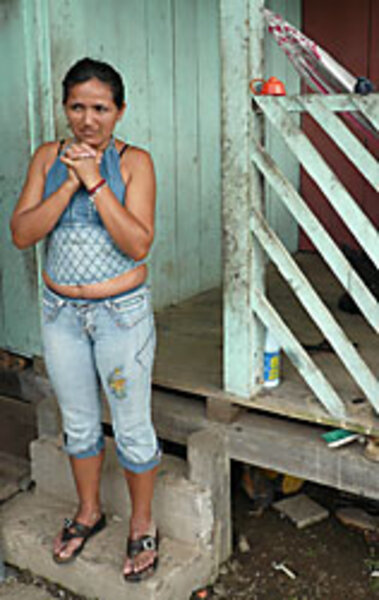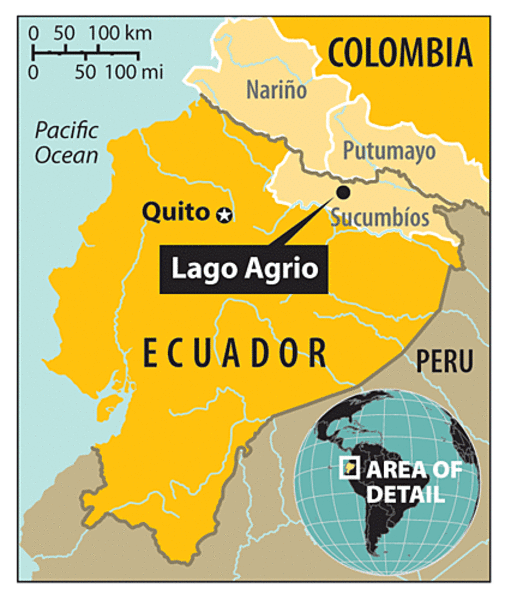Tackling Ecuador's refugee buildup
| Lago Agrio, Ecuador
Less than a month ago, Rosalba Agredo González was given only a few minutes to leave her house in Colombia. She was woken up in the middle of the night by armed men who threatened her and took away her neighbor.
"They told me they wouldn't do anything to me because of my children. Otherwise they would have killed me," she says.
Agredo now lives with her elderly father and her three children in Lago Agrio, a small city in northern Ecuador, 15 miles from the Colombian border. They've made their temporary home alongside one wall of a small wooden house, with only a tin roof, concrete floor, and plastic sheets for walls. She doesn't have a job but sometimes prepares a local pastry at a neighbor's house which her eldest son sells on the street.
Despite her precarious situation, she is happy to be in Ecuador. "I don't want to go back to Colombia, even if I have to maintain myself by selling empanadas," she says. "I feel very happy here because even if I don't own anything I know my children are safe."
Agredo's story is not uncommon. Ecuador has more refugees than any other Latin American country – a consequence of the longstanding conflict in Colombia, which has received little international attention. Five to 10 refugees arrive in Ecuador every day, according to the United Nations High Commissioner for Refugees (UNHCR), mainly from two southern Colombian provinces bordering Ecuador, Putumayo and Nariño.
Given the buildup of refugees, the Ecuadorean government and a few humanitarian agencies are taking measures to provide asylum and assistance.
But the challenges remain large. Of the estimated 180,000 who have entered Ecuador escaping violence, 16,500 have received a refugee visa and 22,000 are awaiting a response.
Trouble securing asylum
The remaining 80 percent have yet to apply – some fear becoming vulnerable to further persecution, while others are unaware they might qualify for asylum.
Asylum seekers are granted access to public health and education from the moment they set foot in Ecuador.
However they often have trouble affording decent housing and supporting their families, as they are not allowed to work until granted a refugee visa.
"Legalizing refugees is very important so that they come out of their invisibility, otherwise they can't get legal jobs and become very vulnerable," says Alfonso Morales, who heads the department for refugees at Ecuador's Ministry of Foreign Affairs. "They become easy prey to illegal networks and often end up participating in illegal activities."
On June 20, to coincide with World Refugee Day, the Ecuadorean Ministry of Foreign Affairs inaugurated a new office in Lago Agrio, an important step toward improving refugee registration. The new office will make registration faster for applicants, as documents will be processed directly instead of being sent to Quito, Ecuador's capital.
Another new measure is an enhanced registration process that will start in September and will make it possible for refugees to apply for and receive their visas in one day.
Right now the registration process takes about four months if applicants can go to Quito and between 18 and 24 months if they can't leave the north.
Isolated, poor communities
But registration is just an initial step in the process of providing better living conditions for refugees. The northern province of Sucumbíos, of which Lago Agrio is the capital, faces the largest influx of refugees. A jungle area separated from Colombia by two rivers, the area also presents many logistical and security challenges for humanitarian work. Border communities here are difficult to access and often lack basic infrastructure such as roads, drinking water, and health facilities.
Though Sucumbíos is rich in oil, the province is among the least developed in Ecuador, with high levels of unemployment and an informal economy that relies on illegal activity such as drug trafficking, weapons smuggling, and human trafficking.
It was in this province that Colombia's cross-border raid on March 1 took place, leaving FARC commander Raul Reyes – and another 25 people – dead and creating a regional diplomatic crisis.
"In small communities the solidarity is amazing. They are willing to share everything, but it's important to intervene quickly so as not to allow tensions to develop," says Xavier Creach, head of the UNHCR field office in Lago Agrio. UNHCR has prioritized reaching those isolated communities along the border.
"We have serious economic and institutional limits when it comes to taking care of the huge quantity of Colombian refugees that have come to our country," says Mr. Morales, the government official. "The international community hasn't yet recognized the magnitude of the problem. We need foreign support."






